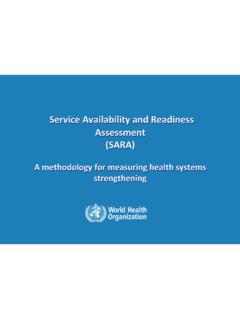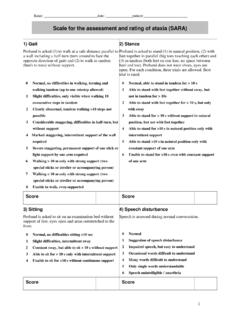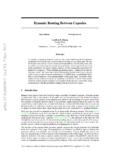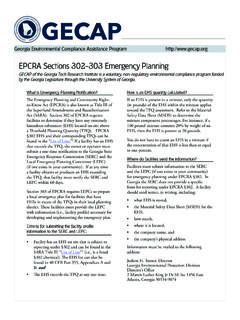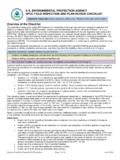Transcription of RELEASE CALCULATIONS - michigan.gov
1 RELEASE CALCULATIONS How to determine the reportable quantity of a product based on the reportable quantity of an ingredient. Example Calculation: When is a RELEASE of gasoline reportable? Under michigan s Natural Resources & Environmental Protection Act (NREPA) Part 201 regulation, releases of CERCLA hazardous substances published in the 2001 version of 40 CFR 302, Table must be reported. Gasoline is not a CERCLA hazardous substance. However, some of the ingredients in gasoline are CERCLA hazardous substances and are reportable under this regulation. This example shows you how to determine when a RELEASE of gasoline in gallons is reportable under NREPA Part 201 based on reportable quantities in pounds of the ingredients. 1. Identify the hazardous ingredients, reportable quantities, and weight percents. Look at the example MSDS for gasoline to find the hazardous ingredients and the weight percents of those ingredients.
2 Look at the List of Lists to find the reportable quantity of an ingredient that is a CERCLA hazardous substance. The List of Lists is available on the Internet: go to Benzene (CAS number 71-43-2) is a CERCLA hazardous substance listed in the List of Lists. The reportable quantity (RQ) for benzene under CERCLA is 10 pounds. That means that a RELEASE of 10 pounds or more of benzene to the environment must be reported to the DEQ Remediation & Redevelopment district office (or PEAS after hours). The weight percent of benzene in the example gasoline is to 5%. When calculating a reportable RELEASE , use the higher, more conservative, weight percent. 2. Calculate the weight of the gasoline. Because the gasoline is a liquid measured in gallons, and the reportable quantity of benzene is in pounds, we must calculate the weight of a gallon of gasoline. The formula is as follows: Specific gravity of the product x lb/gal (weight of water) = weight of the product in lb/gal The specific gravity, also called the relative density, can be found in the Physical & Chemical Properties section of the MSDS.
3 It is a unit-less number that tells how much the substance weighs relative to the weight of water. If the specific gravity is 1, the substance weighs the same as water. If it is less than 1, then the substance weighs less than water. If you think about this logically, you know that gasoline floats on water (thus the sheen you see on water at boat launches), so you can conclude that gasoline must weigh less than water. The specific gravity is often reported as a range. In this example, the specific gravity is reported on the MSDS as a range of to If you plug these values into the calculation, this gasoline can weigh anywhere from lb/gal to lb/gal. When calculating a reportable RELEASE , use the higher, more conservative, value. Thus the weight we will use for our example gasoline is lb/gal. 3. Calculate the smallest reportable RELEASE of gasoline under NREPA Part 201 based on the ingredient benzene.
4 Here is the formula: RQ of ingredient (lbs) weight of product (lb/gal) weight % of ingredient = reportable gallons of product Using the numbers we have determined above, we get: 10 lb (RQ benzene) lb/gal gasoline .05 (wt. % benzene) = 32 gallons of gasoline (reportable if released). The following graph shows how the reportable quantity of gasoline varies with the weight percent of benzene. Smallest RELEASE of Gasoline Reportable under Part 201 Based on lb/gal & Benzene159795340320204060801001201401601 8012345 Weight % BenzeneGallons of Gasoline There would be a smaller reportable quantity (the line would shift down) for heavier gasoline. Look at all hazardous ingredients to determine which one would control the reportable quantity. The controlling ingredient is the one that results in the smallest reportable quantity. For gasoline, the controlling ingredient is benzene.
5 In real life, this is not an exact science. Use this as a way to come up with educated guesstimates for when to report. For gasoline, report any RELEASE that looks like it is approaching 30 gallons or more. Keep in mind that smaller releases of gasoline are potentially reportable under other regulations ( if the RELEASE reaches surface or groundwater). Also remember that all releases must be cleaned up to the extent specified in the regulations. This includes releases that are not reportable under any regulation. In summary: When determining reportable releases, it is important to realize that it is sometimes the ingredients in a given product that make the RELEASE of the product reportable. There are three main steps in the process for determining when a RELEASE of a product is subject to reporting based on the reportable quantities of the ingredients: 1. Identify the hazardous ingredients, corresponding reportable quantities, and weight percents.
6 This depends on the regulation! 2. If the product is a liquid and the reportable quantity of the ingredient is given in pounds, calculate the weight of the product in pounds per gallon. If the product is a solid, skip this step. 3. Calculate the smallest reportable RELEASE using the formula on page 1. If the product is a solid, the formula is simply: RQ of ingredient (lbs) weight % of ingredient in solid product = reportable pounds of solid product.











